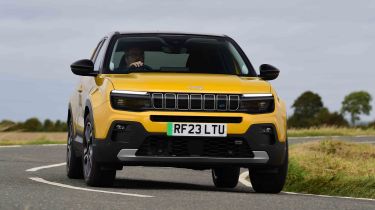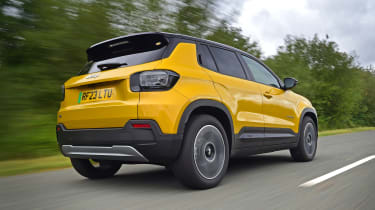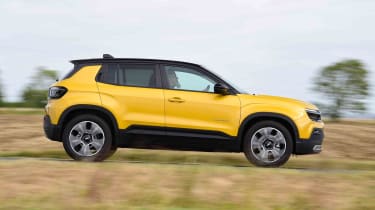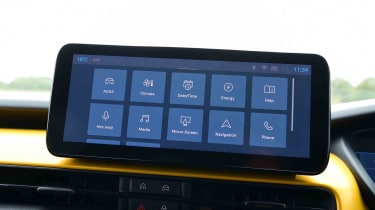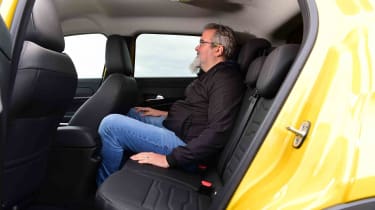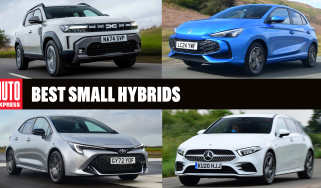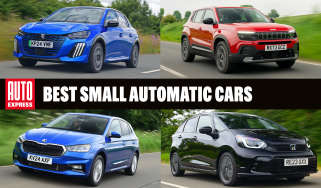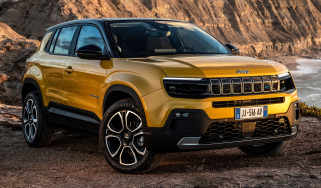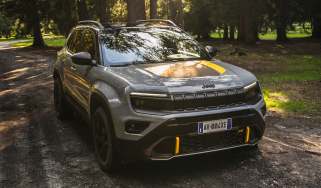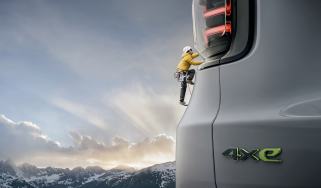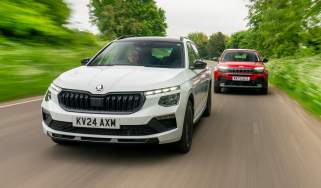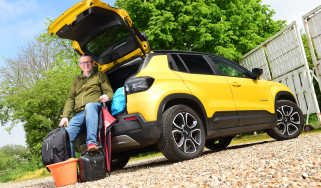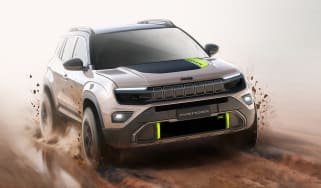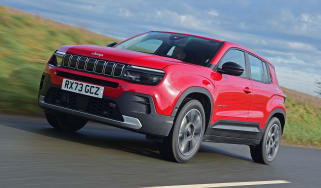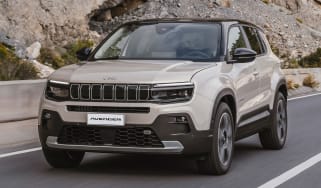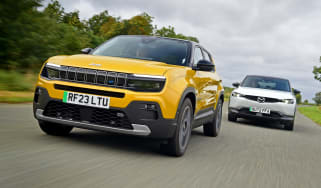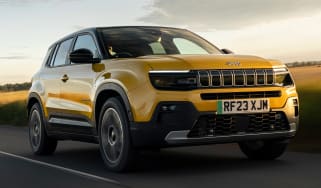Jeep Avenger review
Jeep’s charming little SUV will win hearts with its looks alone, but it’s more than just a pretty face

Is the Jeep Avenger a good car?
Whether you choose the Jeep Avenger in petrol or all-electric forms, you’ll get an enticing small SUV with hidden depths beyond its attractive exterior. We’ve no doubt that a few examples of Jeep’s little bundle of joy will be sold based solely on how it looks, but the Avenger boasts much better tech than any of the brand’s previous offerings we’ve tested so far, and the EV version offers a usable range.
Sure, it’s not the Jeep you’ll want for tackling the Appalachian trail, but it feels right at home in the hustle and bustle of packed city streets, and is decent to drive. The addition of petrol-powered models has also made the Avenger more accessible, not least by bringing the starting price down. However, the limited space available for rear passengers will be a shortcoming that might rule this out for some potential buyers.
| Key specs | |
| Fuel type | Petrol, mild-hybrid, electric |
| Body style | Small SUV |
| Powertrain | 1.2-litre, 3cyl, turbo, petrol, front-wheel drive 1.2-litre, 3cyl, turbo, petrol plus 1x e-motor, front-wheel drive 54kWh battery, 1x e-motor, front-wheel drive |
| Safety | 3-star (Euro NCAP, 2024) |
| Warranty | 3yrs |
Jeep Avenger: model range, specs and rivals
The Avenger was initially launched in the UK as an EV, but a cheaper petrol version has since arrived that starts at a little under £25,000, followed by a more efficient e-Hybrid at around £26,000. The fully-electric model costs around £30,000 before finishing just shy of £34,000 for a top-spec Summit model. The four-wheel drive 4xe version starts at around £31,000 in Upland form, before topping out at £35,000 for The North Face edition.
The Avenger is based on the same CMP/e-CMP platform as the Peugeot 2008, Vauxhall Mokka, Citroen C4 and DS 3, and their all-electric counterparts. Underneath the floor in the EV version lies a 54kWh battery pack that’s used to power the single electric motor that drives the front wheels. Some die-hard Jeep fans will see this as being sacrilegious, but a 4xe version with all-wheel drive using the e-Hybrid powertrain is also available.
The pure-petrol models feature a turbocharged 1.2-litre three-cylinder engine and six-speed manual gearbox, while a mild-hybrid setup powers the Avenger e-Hybrid. This combines a 1.2-litre petrol engine with a 28bhp electric motor integrated directly into the six-speed automatic gearbox, and powered by a small lithium-ion battery. The hybrid setup offers the ability to drive at low speeds on pure-electric power but costs roughly £1,000 more than the regular petrol engine.
The trim structure for the Avenger is straightforward: e-Hybrid and electric models are available in Longitude, Altitude and Summit trim, while the pure-petrol version can only be had in either Longitude or Altitude specifications.
Entry-level Longitude models get 16-inch alloy wheels and automatic LED lights, plus a 10.25-inch central touchscreen, Apple CarPlay and Android Auto connectivity, a seven-inch digital driver’s display, rear parking sensors, cruise control and a handful of other safety systems. Several drive modes, including specific settings for Mud, Sand and Snow, and a hill descent system, are also standard, so the Avenger should be able to handle a bit of wet or slippery terrain if the occasion arises.
Stepping up to Altitude adds a larger 10.25-inch digital dash, 17-inch wheels, keyless entry, adaptive cruise control, a power tailgate, different interior upholstery, and an additional USB port in the rear. Top-spec Summit cars get level 2 autonomous driving tech, 18-inch wheels, heated seats and a 180-degree reversing camera, among other extras. Option packs can be added to all trims, packaging key bits of kit together.
How much does the Jeep Avenger cost?
Jeep Avenger prices start from £24,999 and go up to £30,999. The Auto Express network of trusted dealers is currently offering discounts on those recommended retail prices of up to £5,975 via our Find a Car service. Alternatively, you can lease a Jeep Avenger from around £294 per month.
Engines, performance & drive
Previous Jeeps have often compromised on-road manners for their ability off-road, but not the Avenger
In keeping with the brand’s off-road heritage, the Jeep Avenger rides higher than some of its closest rivals and offers generous ground clearance to clamber over obstacles. There’s good all-round visibility thanks to the raised ride height, and a squared-off bonnet makes it easy to place the car on the road.
The vast majority of the petrol, hybrid and electric range is front-wheel drive, but there will be a four-wheel drive version called the 4xe, which is quite rare for the small SUV class, with only a tight-knit group of rivals such as the Lexus LBX and Toyota Yaris Cross offering the benefits of four-wheel drive traction for slippery conditions.
In addition to the usual Eco, Normal and Sport drive modes, there are Mud, Sand and Snow settings, and a hill descent system. Our experiences have been limited to lightly rutted dusty tracks, but we’d wager the Avenger could show its SUV rivals a clean pair of heels over wet or slippery terrain - especially in 4xe form.
| Model | Power | 0-62mph | Top speed |
| Avenger 1.2 GSE 100 manual | 99bhp | 10.6 seconds | 114mph |
| Avenger 1.2 e-Hybrid 136 4xe DCT6 auto | 134bhp | 9.5 seconds | 121mph |
| Avenger Electric 156 auto | 154bhp | 9.6 seconds | 93mph |
What is the Jeep Avenger like to drive?
In town
The Avenger does a good job of dealing with harsh potholes at low speeds, because the suspension soaks them up without too much crash into the cabin. We feel that the steering could do with a bit more weight and feel, but the upside of the light setup is it makes the car super-easy to drive around town.
Although the least powerful petrol doesn’t look to offer the sort of shove off the line required to mix it with city traffic, but in reality, it has a generous hit of low-down torque, so you can make it into gaps in the traffic without too much trouble. It could use a slicker six-speed gearbox, though, which isn’t as pleasant to use as the ones in the Kamiq or Puma.
In the electric Avenger, there’s a brake regeneration system, although it isn’t strong enough to allow for one-pedal driving, which is a shame for a car so adept at city driving. In fact, it can be hard to discern when you’re driving in the regular ‘D’ mode, which allows the car to coast more, or the ‘B’ mode, which activates the regenerative braking, because its effects are so subtle.
On A- and B-roads
While the Avenger might be capable of dealing with potholes at low speeds, it struggles once you up the pace out of town to smother smaller bumps as well as a Kamiq can. It also lacks the body control of a Puma, and so the body of the Avenger leans more in corners. It maintains a decent level of grip, but this isn’t the sort of car you drive quickly for fun.
This is also due to the steering, which isn’t brimming with feedback and seems a little vague around the straight-ahead position.
The Electric Avenger is responsive enough in its Normal mode to keep up with the flow of traffic on faster roads, but switching to its Sport setting sees throttle response become snappier, which takes a bit of getting used to. If you’re in Normal mode and need the extra power for an overtake, there’s an auto-style ‘kickdown’ in the pedal travel that unlocks maximum power.
On the motorway
The Avenger provides decent comfort on longer journeys, with respectably low levels of wind and road noise for a small SUV. The regular petrol engine blends into the background, as does the EV version's electric motor. All versions feel stable at high speed, but the ride is a touch bumpier than rivals such as the Kamiq.
Engines, 0-60 acceleration and top speed
The pure-petrol uses a turbocharged 1.2-litre three-cylinder (also used in the Peugeot 2008 under the ‘PureTech’ badge) engine that produces 99bhp and 205Nm of torque, and is paired exclusively with a six-speed manual gearbox. The official 0-62mph time is 10.6 seconds, which may sound slow, but the petrol Avenger provides a decent amount of punch, and doesn’t need to be worked very hard when accelerating up to motorway speeds. However, this engine has very little inertia, losing revs quickly when you dip the clutch during gear changes, and making it hard to shift smoothly unless you do it slowly; rushing things causes the car to lurch. This also becomes an issue downhill, where engaging a lower gear doesn’t result in a lot of engine braking.
The Avenger e-Hybrid’s mild-hybrid powertrain combines a 1.2-litre petrol engine with a small electric motor and six-speed automatic gearbox, and makes the same 99bhp combined as the regular petrol version. The electric motor is integrated directly into the transmission, and is powered by a small lithium-ion battery to provide instant torque to the engine, which is useful when accelerating away from a stop. According to Jeep, its 0-62mph time takes 10.4 seconds, while its top speed is the same as the pure-petrol model at 114mph.
The all-electric version uses a single electric motor to drive the front wheels. It pumps out up to 154bhp and 260Nm, which is enough to propel the Avenger from 0-62mph in 9.6 seconds. In Normal mode, the little SUV accelerates at a leisurely pace, clearly not in a hurry to go anywhere. Switching to Sport mode unlocks the maximum power output and delivers a big hit of torque when you first put your foot down, but after that initial hit of performance, it feels much the same as its regular Normal driving mode. Either way, the electric motor feels punchy enough for most situations, especially when you’re in town. It’s only pulling onto motorway slip roads or when overtaking that the Avenger can feel a little short on shove.
The upcoming 4xe model has 134bhp to play with, and thanks to the extra power available compared with the regular petrol and mild-hybrid versions, it gets from 0-62mph in 9.5 seconds, while its top speed is 121mph.
MPG, emissions & running costs
The electric Avenger’s range and charging speeds are decent but not class-leading; petrol and mild-hybrid models are reasonably efficient
The base Jeep Avenger petrol model can return up to 50.4mpg, but we managed to achieve 40.8mpg during our testing, in which we covered close to 350 miles, mostly on motorways.
The mild-hybrid Avenger e-Hybrid offers improved fuel efficiency over the pure-petrol model, with Jeep claiming it will return up to 57.1mpg. This version’s CO2 emissions are down slightly on the pure-petrol model: 111-114g/km compared with 127-130g/km.
| Model | MPG | CO2 | Insurance group |
| Avenger 1.2 GSE 100 manual | 50.4mpg | 131g/km | 22E |
| Avenger 1.2 e-Hybrid 136 4xe DCT6 auto | 51.4mpg | 124g/km | 22E |
| Avenger 1.2 e-Hybrid 100 DCT6 auto | 57.6mpg | 111g/km | 22E |
Electric range, battery and charging
The electric Jeep Avenger uses the same battery and motor technology that powers the updated versions of the Peugeot E-2008 and DS 3 E-Tense, among others. Under the floor is a 54kWh battery, 51kWh of which is usable. Jeep says it can provide enough juice to cover up to 248 miles across a mixture of driving conditions. That’s less than cars such as the Hyundai Kona Electric, but still competitive for this size of electric SUV.
During our twin test between the Avenger EV and Mazda MX-30, the Jeep returned 4.3 miles per kWh, trumping the Mazda’s 3.6mi/kWh by quite some margin. We achieve that figure even after some long journeys on the motorway, so we expect to see even better numbers if you spend most of your time driving in town at low speeds. Either way, the Avenger EV comfortably provides 200 miles of range from a charge.
Speaking of which, the Jeeps’ charging speeds are also on par with most of its main rivals, but again, not class-leading. The Avenger’s 100kW maximum charging speed is still enough for a 20-80 per cent top-up in 24 minutes, though. Fully charging a flat battery at home using a typical 7.4kW home wallbox should take around seven and a half hours.
| Model | Battery size | Range | Insurance group |
| Avenger Electric 156 auto | 54kWh (51kWh useable) | 248 miles | 24E |
Tax
For business users, the all-electric Avenger attracts the lowest Benefit-in-Kind (BIK) rates, plus it is exempt from road tax (VED) and the London Congestion Charge until 2025. The e-Hybrid 100 is the most economical, and has the lowest emissions of the non-electric Avenger range, and is the next best company car choice.
No version of the Avenger costs over £40,000 when new, and avoids falling into the luxury car tax band.
Insurance groups
Insurance ratings for the petrol and mild-hybrid variants are still yet to be confirmed, but the EV sits in insurance groups 24 or 25 (out of 50), depending on which trim level you go for. That means it attracts similar ratings to the 48kWh Hyundai Kona Electric and facelifted Peugeot E-2008. The regular petrol and hybrid range starts in a more affordable group 22, but no version can quite match the low insurance group ratings of the SEAT Arona, which starts in group 10, or Renault Captur in group 11.
Depreciation
According to our latest expert data, the Jeep Avenger will retain 48-50 per cent of its original value after three years of ownership and with 36,000 miles on the clock come trade-in time. The 1.2 e-Hybrid 100 DCT6 Longitude is expected to hold onto the most value compared with the rest of the range.
To get an accurate valuation for a specific model, check out our free car valuation tool...
Interior, design & technology
The Jeep Avenger looks great and features iconic Jeep design cues and ‘easter eggs’ all over the exterior and interior
The design team’s brief for the Avenger was to fit “100 per cent of the brand DNA into four metres”, and frankly, they nailed it – even from 100 feet away, you know this is a Jeep. While other small SUVs feature curvaceous bodywork or a swooping roofline to look futuristic or help with aerodynamics, the Avenger has an unashamedly chunky and squared-off shape with a broad, planted-looking stance to give it more attitude.
At the front is an evolution of Jeep’s iconic seven-slot grille, and overall, the Avenger does have a slightly aggressive face. But because of just how small it is, it reminds us of a puppy that enjoys growling at the postman in the morning.
There’s extensive cladding along the side of the car and the wheel arches, which give it the essence of a rugged off-roader and have the additional benefit of being more resistant to knocks and scuffs. The rear is simple, with more black plastic and tail lights with an X-shaped motif.
Jeep has also hidden lots of ‘easter eggs’ around the Avenger, including lots more seven-slot-grille motifs on the rims and front air intake, and a small illustration of the designer's son looking through a telescope at the stars in the corner of the windscreen.
There are many paint colours for buyers to choose from, including two-tone schemes like our test car's Sun yellow and Volcano black roof. Opting for this particular combo also gives you the option of a yellow dashboard, which brightens up the cabin. However, you have to go for the yellow and black paint, and top-spec Summit trim, to unlock that as an option, which is a shame because we bet many customers would pay to inject a bit more colour into the already quite funky cabin.
Thankfully, Jeep offers plenty of other accessories to help distinguish your Avenger from the rest, including graphics for the bonnet and grille, 18-inch wheels with blue accents, and the usual assortment of roof racks and rubber mats for the boot and footwells for more outdoorsy owners.
What is the Jeep Avenger like inside?
Inside, the cabin uses chunky toggle buttons on the dashboard, and a number of big buttons on the steering wheel and centre console. We’re not too fond of the interior light controls on the roof, though, because the unit looks like it came from the decade-old Fiat Panda.
While we approve of the use of physical buttons in the Avenger to control frequently used features, such as the climate control, we prefer the simpler dial set-up used in the Kamiq. However, making small adjustments in the Avenger is still less distracting compared to the Puma, which has gone all in on touchscreen controls.
What is the interior quality like?
The swathes of hard plastic inside the Avenger may be rugged and reasonably hard-wearing, but it lacks the premium feel of something like the Skoda Kamiq, which uses more soft touch materials and has controls that emit a satisfying click, and buttons that have that typical Volkswagen feel of being well damped.
Sat-nav, stereo and infotainment
The Avenger’s infotainment system is a significant improvement on older Jeep tech. The larger 10.25-inch screen we’ve tried so far is a good size, and it’s responsive. Standard-fit wireless Apple CarPlay and Android Auto ensure buyers can utilise apps from their phones. There’s a large storage cubby that lives below a row of climate controls, and there’s a proper volume dial for the audio system. There are physical ‘home’ and ‘settings’ buttons located just below the touchscreen; however, they’re small and not illuminated, so it may take a while to develop the muscle memory required to find these at night.
Boot space, comfort & practicality
The Jeep Avenger’s ability to carry more than two people depends largely on who’s up front
Jeep claims there are 34 litres of storage in the front of the Avenger’s cabin – enough, apparently, to stash the contents of a carry-on suitcase among its various cubbies. The one below the central infotainment screen is handy and is accessed via a tablet-style magnetic cover on certain models. It’s deep, and in top-spec cars, hides a handy wireless phone charger large enough to accommodate even the biggest of smartphones.
There’s also a handy shelf in the dashboard for your passenger’s phone, or perhaps to keep your wallet and keys in sight. The centre console features movable dividers that can serve as cup holders, with even more storage space in a deep cubby beneath the armrest. The front door bins are on the thin side, though, and there aren’t any in the rear. There’s also just one USB-C charging port in the back, so kids might have to squabble over who charges up their tablet on longer journeys.
| Dimensions | |
| Length | 4,084mm |
| Width | 1,776mm (1,981mm inc mirrors) |
| Height | 1,536mm |
| Number of seats | 5 |
| Boot space | 321-1,277 litres (petrol), 282-1,252 litres (electric), 262-1,218 litres (4xe) |
Dimensions and size
At 4,084mm long, 1,776mm wide and 1,528mm tall, the Avenger is a very compact car – one of the smallest in its class, in fact. It’s 126mm shorter than a Nissan Juke, and 216mm shorter than the Peugeot 2008, despite sharing that car’s basic platform. The Avenger’s only 24mm longer than a Vauxhall Corsa supermini, though its compact dimensions make it adept at navigating tight city streets.
How practical is the Jeep Avenger?
Seats & space in the front
Visibility is good from the driving seat, and the squared-off bonnet makes the car easy to place on the road. Its boxy shape also allows for an impressive amount of headroom up front, with enough shoulder for a pair of adults over six feet tall.
The seats are comfortable, with decent side bolsters, so you don’t feel like you’ll slide out of them through the corners. Even drivers who are six-foot tall or above should have no problem finding a comfortable driving position thanks to lots of adjustment in both the seat and steering wheel.
Seats & space in the back
However, rear legroom is somewhat on the tight side, and if the driver is tall, there’s only enough room in the back for small kids. With someone smaller in stature at the wheel, and the front seats a little further forward, you might just be able to accommodate two adults at a push, but we doubt the Avenger can seat five as Jeep has claimed. However, we like that the backs of the front seats are squishy, so rear passengers’ legs aren’t crushed against hard plastic if they need to squeeze in.
There are three sets of ISOFIX mounting points in the Avenger – one on the front passenger seat, and the remaining two on the rear seats' outer positions. However, the small rear door openings could make installing a child seat a little trickier than in some rivals.
Boot space
The Avenger offers 321 litres of space (282 litres in the electric version and 262 litres in the 4xe), which is slightly better than a Vauxhall Corsa supermini, but somewhat shy of family hatchbacks like the Volkswagen Golf.
However, the one-metre-wide opening and nice square shape of the load bay also boost practicality, while folding the rear seats down gives you a total of 1,277 litres (1,252 litres in the electric version and 1,218 in the 4xe) of space to play with. There’s no ‘frunk’ or storage under the bonnet of the EV like you get in a Hyundai Kona Electric, but there’s enough space under the boot floor to keep the charging cable out of sight.
Reliability & safety
The Jeep Avenger uses tried-and-tested parts from the Stellantis family of brands, which includes Vauxhall, Citroen and Peugeot
The Jeep Avenger only received a disappointing three-stars out of a possible five from safety experts Euro NCAP when put through the updated test in 2024. That’s a bit disappointing when one of our favourite small SUVs, the Renault Captur, gets four stars.
The Avenger was criticised for not having a central airbag between the front seat occupants to protect them from striking each other in a side impact, and not having a rear child presence detection system. There were also concerns over pressure on the chests of rear seat occupants in a head-on crash, and not having a good enough system for detecting vulnerable road users.
In terms of safety kit, every Avenger is equipped with six airbags, ISOFIX on the front passenger and rear seats, cruise control, lane departure warning, traffic sign recognition, drowsy driver detection, traction control and rear parking sensors. Mid-range Altitude-spec models add adaptive cruise control, while range-topping Summit cars feature lane centring and traffic jam assist, along with a 180-degree rear-view camera and automatic high/low beam.
The Avenger is also too new to have appeared in our 2024 Driver Power owner satisfaction survey, and the Jeep brand didn’t appear on the manufacturer’s list either. There is some hopeful news: the Peugeot 2008 (upon which the Avenger is based) came in sixth place overall out of 50 cars, which is an excellent result, and one that we’d hope this small Jeep might replicate.
| Key standard safety features | Euro NCAP safety ratings |
|
|
Warranty
The Avenger comes as standard with a three-year warranty, but you can get four years of warranty coverage, plus complimentary servicing and roadside assistance for the same period if you sign up with Jeep Shield. The electric Avenger’s battery gets a separate eight-year/100,000-mile warranty, which can be extended by three years.
Servicing
The Jeep Avenger comes with the Jeep Shield after-sales package, which includes 24 months of complimentary servicing, four years of warranty cover and 24/7 roadside assistance.
The service schedule for the Jeep Avenger varies depending on the model you get. Internal-combustion versions need to be serviced every 12 months or 12,500 miles, while the EV requires an initial service after 12 months or 8,000 miles, whichever comes first, then every two years or every 16,000 miles after that.
Jeep Avenger Summit long-term test
Former Editor-at-large, John McIlroy, ran a top-spec Jeep Avenger Summit for six months as part of the Auto Express long-term fleet. During his time with this baby electric SUV, he felt that it had the character of a proper ‘all-American’ Jeep, even though it was designed for the European market. He was a fan of the chunky styling, and the Jeep even lived up to its badge as it proved reasonably capable at off-roading.
Despite sharing underpinnings with Peugeot E-2008, Vauxhall Mokka Electric and Citroen e-C4, John believed that the Avenger felt precisely like a baby Jeep should. You can read the full long-term test here…
Jeep Avenger alternatives
With a choice of petrol, hybrid and electric power, the Jeep Avenger has to compete with a vast array of small SUVs.
Those include the best-selling Ford Puma, Renault Captur, Nissan Juke and Volkswagen T-Cross, plus smaller electric SUVs like the Smart #1, Kia Niro EV, Peugeot E-2008 and our own Car of The Year for 2023, the Hyundai Kona Electric.
Because of how small and nimble it is, the Avenger also threatens style-focused zero-emission city cars like the Mazda MX-30 and MINI Cooper.

